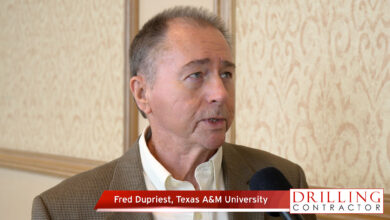Coiled-tubing cementing operation on HPHT well uses MPD technique to lower costs, ensure integrity
Automated MPD, flow monitoring deployed on Canada’s Fort Liard field helps to maintain constant bottomhole pressure and ECD, eliminate fluid losses
By Elvin Mammadov, Nadine Osayande, Ali Yousefi Sadat and Muhammad Murtaza, Weatherford
The number of exploration wells drilled in high-pressure, high-temperature (HPHT) environments keeps growing, spurred by the ongoing search for new oil and gas reserves. Per the Norwegian Standards Organization (NORSOK), an HPHT well has a wellhead shut-in pressure exceeding 69 MPa (10,000 psi) and an ambient temperature greater than 150°C (302°F). These operating conditions present a number of well construction challenges, many related to the narrow window between pore pressure and fracture pressure. Keeping a well within this window is a significant challenge for conventional drilling and completions techniques.

Managed pressure drilling (MPD) techniques have proven effective for controlling and maintaining drilling parameters within narrow pressure windows. MPD encompasses a variety of techniques, including manipulation of surface backpressure (SBP), fluid density, fluid rheology, annular fluid level, circulating friction and hole geometry. By precisely controlling the annular pressure profile through the wellbore, MPD mitigates the costs and risks of drilling these wells.
The same challenges that a narrow pressure window presents to the drilling process also complicates cementing operations. Bottomhole pressure (BHP) must be carefully managed at all times while cementing the open-hole section, and hydrostatic and dynamic effects must be accounted for if the BHP is to be safely maintained within the appropriate window.
Just as MPD controls annular pressure during drilling, the same techniques can adjust fluid properties and flow rates during cementing to achieve the necessary BHP. By increasing or decreasing SBP on a choke manifold, one can mitigate any change in BHP and minimize the impact of kicks or losses during cementing.
MPD for coiled-tubing operations
An operator constructing a slim-hole, HPHT exploratory well near Fort Liard, British Columbia, in the Northwest Territories of Canada anticipated needing a pressure management solution during cementing due to the challenging field conditions observed while drilling.
The well had a narrow pressure window, complex wellbore geometry and elevated temperatures and pressures, all of which threaten cement integrity. High downhole temperatures and pressures can dramatically change the rheological behavior of the cement, raising the risk of incomplete curing, the creation of gaps or channels in the cement, or a weak bond between the cement and the wellbore. As a result, the cementing operation would take longer to complete and increase the risk of gas migration after cementing.
Complicating matters further, the well site was in a remote location, which created expensive logistics challenges. Equipment, supplies and personnel had to be transported in and out of the field via helicopter. The complexity of the reservoir and remoteness of the field combined to make this exploratory well one of the most expensive that the operator had ever drilled, with a total cost between $28 million and $38 million.
The operator approached Weatherford to help develop a cementing solution that would lower the cost of the operation, while ensuring a high-integrity cement job with minimal risk of damage to the formation. Engineering representatives from both companies worked together to devise a precise managed pressure cementing operation.
Because this was a slim-hole well, the team decided to deploy a coiled-tubing (CT) string to pump the cement slurry downhole. Coiled tubing offers several operational and economic advantages. Because it is one continuous string, CT eliminates the connection time required with conventional drill pipe. With its smaller diameter, CT reduces the surge and swab effects that are common with larger outside diameter (OD) drill pipe, thus minimizing any damage to the formation. The slim-body CT string also affords greater flexibility in choosing the optimal pump rate to control frictional pressure losses while circulating.
The operator and service provider elected to use the Microflux automated MPD control system to manage the pressure of the cementing operation through the coiled tubing. Unlike traditional MPD equipment, the system affords real-time detection and automated control of minute downhole influxes and losses – in gallons rather than barrels of fluid – to minimize the risk of well control incidents and enhance the efficiency of the cementing operation. The control system includes a rotating control device (RCD) to keep the well closed and an automated choke manifold to regulate the flow of fluids from the well. A Coriolis meter installed inline with the chokes measures return flow and provides early detection of fluid gains or losses.
Because MPD equipment creates a closed-loop system, it provides an additional level of safety to the rig and its personnel in the event of fluid loss or a kick. The control system’s automated functionality quickly alters the SBP on the choke manifold to adjust BHP and restore equilibrium, all while reducing risk and improving operational efficiency. All critical parameters are recorded in real time and displayed graphically on a computer monitor. Figure 1 shows a process flow diagram illustrating the layout of all equipment involved in this operation.
Before starting cementing operations, the team used hydraulic simulation software to update mud, cement, washer and spacer properties – all of which were used to calculate the target BHP that would keep the wellbore safely in the drilling window. A displacement schedule was provided to simulate the bottomhole equivalent circulating density (BH ECD) at different flow rates. Additionally, because of the lower clearance available in the slim-hole well, the team performed a detailed surge analysis to determine the optimal CT run speed to prevent formation fracture. By continuously measuring the fluids return temperature and applying a temperature gradient, the team was able to predict the bottomhole circulating temperature (BHCT).

Operational procedure
The team performed the cementing operation while holding the BH ECD constant, using the procedure described below.
Running coiled tubing in hole
The wellhead swab valve was opened and shut-in tubing-head pressure (SITHP) was equalized using invert mud prior to running the CT string in hole. While running in the CT at 20 m/min (66 ft/min), the invert mud was circulated at a minimum rate of 0.3 cu m/min (10.6 cu ft/min). A pull test was performed every 500 m (1,640 ft), and the tripping speed was reduced to 5 m/min (16 ft/min) while running in the open-hole section to minimize the surging effect. The required cement volume was calculated when the bottom of the hole was tagged with the tubing head.
Displacing the well to lighter mud through the CT
The 2,020-kg/cu m (16.9-lb/gal) kill mud in the well was displaced with a lighter 1,890-kg/cu m (15.8-lb/gal) mud prior to pumping the cement slurry (Figure 2). The BH ECD was monitored to ensure it remained constant at 2,015 kg/cu m (16.8 lb/gal). While displacing the well to the lighter mud, the initial pump rate of 0.27 cu m/min (9.5 cu ft/min) was gradually increased to a maximum rate of 0.4 cu m/min (14.1 cu ft/min) to compensate for annular frictional pressure and hydrostatic pressure drop in the wellbore. The SBP was then applied and gradually increased to 4,000 kPa (40 bar) to keep the BH ECD constant at 2,015 kg/cu m. A second bottoms-up was circulated to ensure that there was no gas in the wellbore prior to the cementing operation. The SBP value remained constant at 4,000 kPa during the second circulation.
Pumping cement through CT
Prior to pumping the cement slurry, 3 cu m (19 bbl) of invert pre-flush and invert spacer with a density of 1,910 kg/cu m (16 lb/gal) were pumped. Then, 6.84 cu m (43 bbl) of a thermal cement blend of density 1,885 kg/cu m (15.7 lb/gal) was pumped to plug the open hole from 4,050-m MD to 4,402-m MD (13,287 ft to 14,442 ft). After pumping the first cement blend, CT was pulled out of the hole at approximately 14.63 m/min (48 ft/min) to cement and plug the next open-hole section.
This next section, 3,825-m MD to 4,050-m MD (12,549 ft to 13,287 ft), was cemented and plugged by 5.59 cu m (35 bbl) of a second thermal cement blend, which had a slightly higher density of 1910 kg/cu m (16 lb/gal) than the first.
During cementing, SBP was applied to maintain a constant BH ECD of 2015 kg/cu m (16.8 lb/gal). The SBP value gradually increased from 3,670 kPa to 3,839 kPa (36.7 bar to 38.39 bar) while pumping the first cement blend. For the second cement, the SBP value decreased gradually from 3,863 kPa to 3,360 kPa (38.63 bar to 33.60 bar) due to change in the hydrostatic pressure. The cement plug was then displaced with invert spacer, invert afterflush and 1,890 kg/cu m (15.8 lb/gal) of spacer and invert mud.
Circulate on top of cement and waiting on cement
Once the cement plug was placed, 3,660 kPa (36.60 bar) of SBP was applied to hold the cement plug and maintain the BH ECD constant at 2,015 kg/cu m (16.8 lb/gal). SBP was increased to 3,780 kPa (37.80 bar) once the spacers were circulated out of the well. Then 1,890 kg/cu m drilling fluid was circulated for 8 hrs as a wait-on-cement time, while holding 3,780 kPa SBP in order to maintain BH ECD constant at 2,015 kg/cu m.
Tag top of cement
The hardened cement was tagged at 3,772 m (12,375 ft) after 8 hrs of wait time, and coiled tubing was slowly pulled out of hole while CT volume was replaced by 1,890 kg/cu m (15.8 lb/gal) of invert mud to prevent swabbing effects.
Conclusions
By applying automated MPD technology during CT cementing operations in this HPHT well, the operator was able to maintain constant bottomhole pressure. Additionally, BH ECD remained constant at 2,015 kg/cu m, regardless of changes in CT nozzle depth and pumped-fluid densities during cementing, displacement and tripping operations. Further, real-time flow monitoring eliminated downhole fluid losses and, in conjunction with constant bottomhole pressure, reduced the likelihood of formation damage.
The technique also reduced nonproductive time by eliminating the need for two-stage displacement, increasing pumping rates and mitigating well control issues. Cement-plug integrity was confirmed by stable hole condition and desired cement plug length. By using less weighting materials, managed pressure cementing reduced the total cost of the operation without compromising BHP control. The ability to control BHP though the choke manifold also eliminated the risk of going underbalanced while cementing. Finally, by maintaining flow control after cementing while waiting on cement, the technique minimized the chance of gas migration and improved cement quality.
This managed pressure cementing technique proved valuable in the Fort Liard field. Going forward, the method represents a new option for drilling and cementing HPHT wells in tight formations, without the risk of cost overruns or loss of wellbore integrity. DC
This article is based on a presentation at the 2017 SPE/IADC Drilling Conference, 14-16 March, The Hague, The Netherlands.




